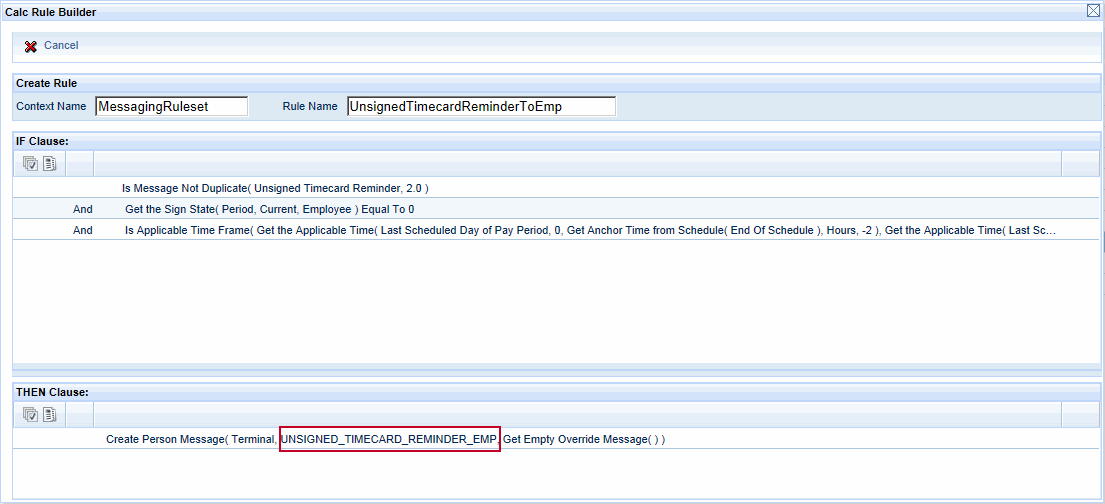
The Message Label tab on the Message Definition form is used to change the text of the messages generated from Messaging Rulesets and Message Definitions.
Note: The Message Label tab cannot be used to edit the text of Dialog Messages. These messages and responses can be edited on the Dialog Element Label form.
You can edit the subject, header, trailer, and body of the email message. To do so, you need to look at the Message Key parameter in the message rule’s Create Message operand. The Message Key contains the name of a Dictionary Label that you can edit using the Message Label tab.
For example, the UnsignedTimecardReminderToEmp rule sends a message to employees before the pay period ends that they need to sign their timecards. In the Create Person Message operand for this rule, the Message Key parameter is UNSIGNED_TIMECARD_REMINDER_EMP.

This Message Key corresponds to a Dictionary Label of the same name. You can edit the subject, header, and other parts of the message email using the Message Label form.

See Also:
Message Label Field Descriptions
Dictionary Name
The name of the dictionary that this label belongs to. Dictionaries are created on the Dictionary form.
Label Name
An identifying name of the record. MESSAGING labels can have multiple Label Types (Email Header, Email Subject, etc.).
Module Name
Type of module to which this label applies. On the Message Label form, the only Module Name is MESSAGING.
Label Type
Indicates where the text of this label will appear.
Label Type |
Description |
Email Header Label |
Text that appears in the header of the email. |
Email Subject Label |
Text that appears in the subject line of the email. |
Email Text Label |
Text that appears in the body of the email, below the Email Header Label. |
Email Trailer Label |
Text that appears below the body of the email (after the Email Text Label). |
Terminal Text Label |
Actual text of the message that appears on the client terminal. |
Long Label
Each Label Name/Label Type has a Short Label and a Long Label. The system will select which label to use based on the size of the button or field. The Long Label can be up to 2000 characters long.
Short Label
Each Label Name/Label Type has a Short Label and a Long Label. The system will select which label to use based on the size of the button or field. The Short Label can be up to 20 characters long.
System Required
This record is system required and cannot be modified. You can make a copy of the record, however, and modify the new record.
Update Date, Updated By
These fields display when the record was created or updated, and the person who created or updated the record.
Note: The Message Label tab cannot be used to edit the text of Dialog Messages. These messages and responses can be edited on the Dialog Element Label form.
Click Main Menu > Configuration > Policies > Message Definition.
Click the Message Label tab.
Select the Dictionary Name with the message label you want to modify.
Select the Label Name with the message text you want to modify.
Click Find.
The email subject, header, trailer, and text, as well as the terminal text, will appear in the grid.
You can modify the message text by typing directly into the grid.
You can also modify this text using a pop-up window as explained in the steps below.
Select the message text you want to change and click Modify.
On the Modify Message Label form, change the Long Label and Short Label as necessary and click Save.
Use the Add button to create a new email message that can be assigned to a messaging rule.
Click Main Menu > Configuration > Policies > Message Definition.
Click the Message Label tab and then click Add.
Select the Dictionary Name where you want to define this new Message Label.
Enter a name for this new label in the Message Name field.
In the remaining fields, enter the various components of the message.
For example, in the “Subject” fields, enter the text that will appear on the Subject line of the email.
If this message will also appear on the client terminal, enter the Terminal Text as well.
If you want to add more than one Message Label, click Save and Add to save your settings and keep the Add Message Label window open. Or click Save to save your Message Label and return to the main form.
The next time you create or modify a messaging rule on the Calc Rule form, you can assign your new Message Label to the Message Key parameter. See Messaging Rules Operands for more information on the messaging operands and their parameters.
If you select a system-defined Label Name and click Delete All, then the labels will revert to their original values before any modifications were made.
If you select a custom Label Name (that you created using the Add button) and click Delete All, then the Label Name and all its labels will be deleted.